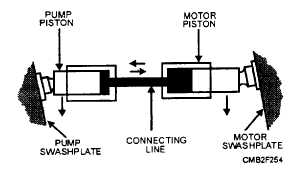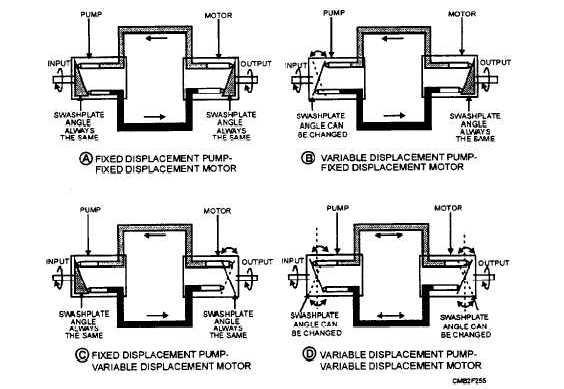Home > Construction Training Manuals > Construction Mechanic Basic Volume 2 > Figure 6-14.Pump And Motor Combinations For Hydrostatic Drives.
To provide a pumping action for the pistons, a plate, called a SWASH PLATE, is located in both the pump and motor (fig. 6-13). The pistons ride against the swash plates. The angle of the swash plates can be varied, so the volume and pressure of oil pumped by the pistons can be changed or direction of the oil reversed. A pump or motor with a movable swash plate is called a variable-displacement unit. A pump or motor with a fixed swash plate is called a fixed displacement unit. There are four pump-motor combinations, which are as follows (fig. 6-14):

Figure 6-13. - Connected cylinders with swash plates.
Fixed displacement pump driving a fixed displacement motor (fig. 6-14, view A). This setup will give you constant horsepower and torque at the output with a steady input speed. If input speed varied, horsepower and speed will vary but torque will remain constant. Because both the pump and motor are fixed displacement, this system is like a gear drive; it transmits power without altering the speed or horsepower between the engine and the load.
Variable displacement pump driving a fixed displacement motor (fig. 6-14, view B). Since the pump is variable, output speed is variable and torque output is constant for any given pressure. This setup provides variable speed and constant torque.
Fixed displacement pump driving a variable displacement motor (fig. 6-14, view C). In this setup changing the motor displacement varies output speed. When motor displacement decreases, output speed increases, but output torque drops. When the setup is balanced, it gives a constant horsepower output.
Variable displacement pump driving a variable displacement motor (fig. 6-14, view D). This setup gives an output of both constant torque and constant horsepower. It is the most flexible of all the setups, but it is also the most difficult to control.

Figure 6-14. - Pump and motor combinations for hydrostatic drives.
Continue Reading